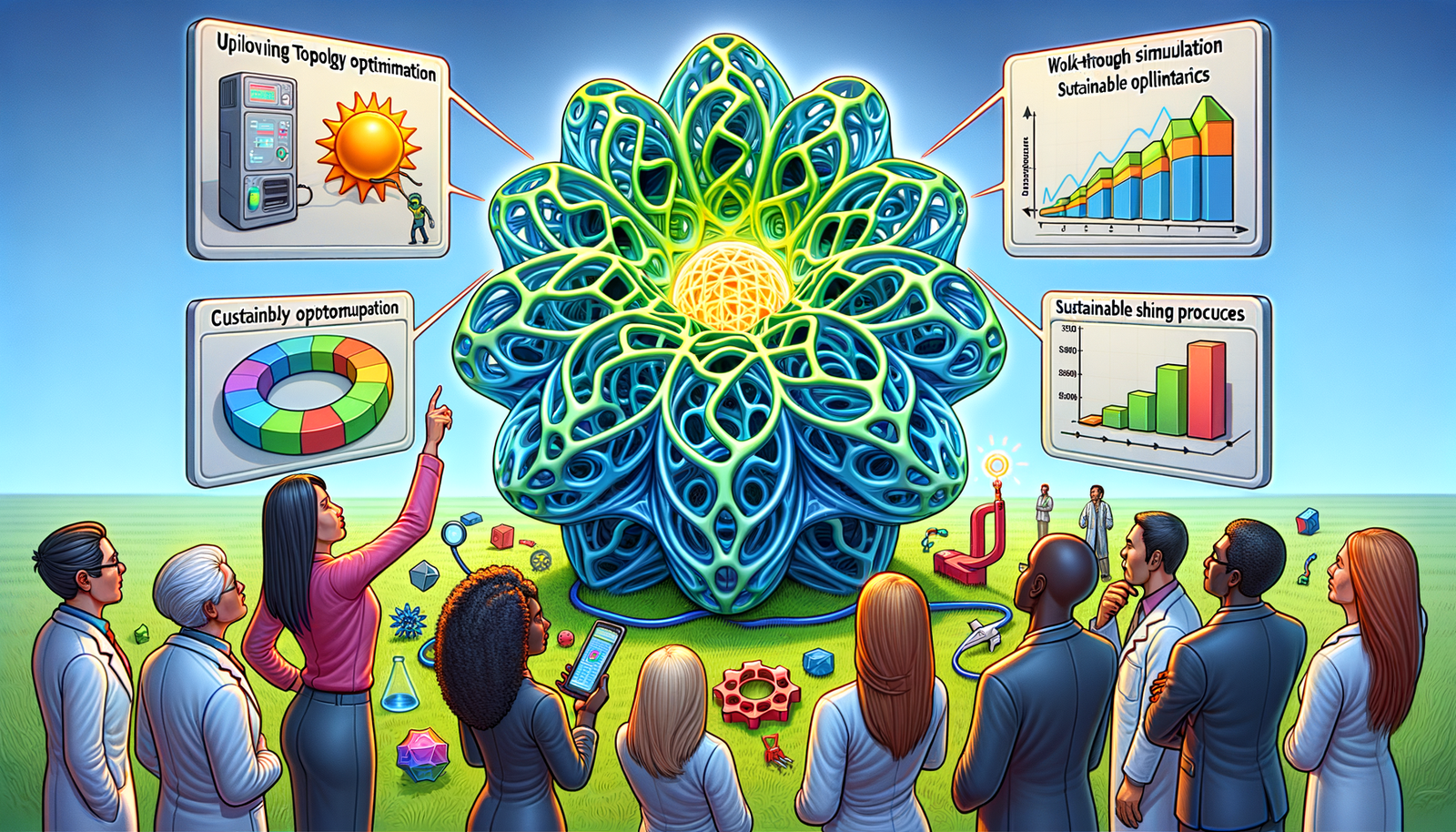Your Cart is Empty
Customer Testimonials
-
"Great customer service. The folks at Novedge were super helpful in navigating a somewhat complicated order including software upgrades and serial numbers in various stages of inactivity. They were friendly and helpful throughout the process.."
Ruben Ruckmark
"Quick & very helpful. We have been using Novedge for years and are very happy with their quick service when we need to make a purchase and excellent support resolving any issues."
Will Woodson
"Scott is the best. He reminds me about subscriptions dates, guides me in the correct direction for updates. He always responds promptly to me. He is literally the reason I continue to work with Novedge and will do so in the future."
Edward Mchugh
"Calvin Lok is “the man”. After my purchase of Sketchup 2021, he called me and provided step-by-step instructions to ease me through difficulties I was having with the setup of my new software."
Mike Borzage
Harnessing Topology Optimization for Sustainable and Innovative Design Solutions
October 18, 2024 7 min read


Introduction to Topology Optimization
Topology optimization is a revolutionary computational approach that refines material distribution within a given design space to achieve optimal performance under specified constraints. Its primary purpose is to determine the best possible layout of material—be it solid, void, or intermediate densities—within a predefined space to maximize or minimize an objective function such as stiffness, weight, or frequency response. This method transcends traditional design by not merely adjusting parameters but by exploring radical new configurations that may not be intuitive to the human designer. By enabling the creation of structures that are both lightweight and strong, topology optimization is critical in developing efficient, sustainable, and innovative designs across various industries.
Historically, topology optimization has evolved dramatically since its inception in the late 20th century. Initially rooted in structural optimization methods focusing on sizing and shape adjustments, the field has expanded due to advancements in computational power and algorithm development. Early techniques were limited by computational constraints, forcing designers to work with simplified models and assumptions. However, as computational resources grew, so did the complexity and applicability of topology optimization methods. The introduction of the homogenization method in the 1980s marked a significant milestone, allowing for the consideration of material microstructures in optimization. This evolution continued with the development of methods like the Solid Isotropic Material with Penalization (SIMP) and Level-set methods, which provided more practical and efficient solutions. The historical progression of topology optimization reflects a transition from theoretical concepts to practical tools that are integral in addressing modern engineering challenges.
In contemporary design processes, topology optimization has become indispensable, especially in engineering and architecture. It empowers engineers to push the boundaries of traditional design by facilitating the creation of components and structures that are optimized for specific performance criteria. In the engineering sector, particularly in aerospace and automotive industries, reducing weight while maintaining structural integrity is paramount. Topology optimization addresses this by identifying areas where material can be reduced without compromising strength, leading to lighter and more fuel-efficient vehicles and aircraft. In architecture, the method contributes to innovative building designs that are both aesthetically pleasing and structurally sound. It enables architects to experiment with organic and complex forms that were previously unattainable due to design and material limitations. The importance of topology optimization in contemporary design lies in its ability to produce efficient, sustainable, and cutting-edge solutions that meet the increasing demands of functionality and environmental responsibility.
Techniques and Methods in Topology Optimization
Several algorithms are central to topology optimization, each offering unique advantages depending on the application. The Solid Isotropic Material with Penalization (SIMP) method is one of the most prevalent techniques. SIMP works by assigning a material density variable to each element within the finite element mesh of the design space. By adjusting these variables between solid and void states and applying a penalization factor, SIMP effectively homogenizes material distribution to find the optimal structure. This method is favored for its simplicity and effectiveness in generating practical designs.
The Evolutionary Structural Optimization (ESO) method takes a different approach by iteratively removing inefficient material based on stress analysis. Elements that carry less stress are considered redundant and are systematically eliminated, allowing the structure to evolve towards an optimal form. This method is intuitive and mirrors natural evolutionary processes, making it accessible and easy to implement.
The Level-set method offers a more mathematically sophisticated approach by representing the structural boundaries as zero-level sets of higher-dimensional functions. This allows for smooth and accurate definition of boundaries and can handle complex topological changes like merging or splitting of material regions. The Level-set method is particularly useful in problems where precise control over the geometry is required.
Computational design tools play an instrumental role in facilitating topology optimization. They provide the necessary platforms and interfaces for implementing the complex algorithms involved. These tools integrate finite element analysis with optimization algorithms, allowing for the simulation of structural behavior under various loads and constraints. They enable designers to set up optimization problems by defining objectives, constraints, and material properties, and then visualize the results in an interactive environment. Computational tools also allow for:
- Automated mesh generation and refinement for accurate simulations.
- Visualization of optimization iterations, helping users understand the evolution of the design.
- Integration with manufacturing constraints, ensuring that optimized designs are feasible to produce.
- Multi-objective optimization capabilities, balancing various performance criteria.
The role of these tools extends beyond mere computation; they enhance creativity by allowing designers to explore numerous design alternatives rapidly. By handling the heavy computational lifting, they free designers to focus on innovation and problem-solving.
Challenges and Limitations
Implementing topology optimization comes with several challenges that can limit its effectiveness. A primary concern is the computational intensity and resource requirements. Topology optimization problems, especially those involving fine meshes and complex loading conditions, can be computationally expensive. The iterative nature of the algorithms requires numerous calculations to adjust the material distribution gradually. This can lead to long processing times, even with powerful computing systems, making it impractical for time-sensitive projects or organizations with limited computational resources.
Material constraints and manufacturability also pose significant challenges. The optimized designs often result in intricate geometries with thin walls, overhangs, and complex internal structures that are difficult or impossible to produce with traditional manufacturing methods. While additive manufacturing has alleviated some of these constraints, not all materials or industries have access to such technologies. Additionally, the optimized structures may not account for real-world material behaviors like anisotropy, residual stresses from manufacturing processes, or material fatigue, leading to designs that are theoretically optimal but practically unfeasible.
Integrating topology optimization with other design processes, such as CAD and simulation tools, can be problematic. The outputs from optimization software may not seamlessly transfer to CAD environments due to differences in file formats or the need for geometry clean-up and simplification. This can result in additional time and effort to remodel or adjust the designs for further development or manufacturing. Ensuring that the optimized design meets all performance requirements across various simulations (structural, thermal, fluid dynamics) adds another layer of complexity.
Current advancements addressing these limitations include:
- Development of more efficient algorithms and the use of parallel computing to reduce computation times.
- Integration of manufacturing constraints directly into the optimization process, producing designs that are both optimal and manufacturable.
- Better material modeling that accounts for real-world behaviors, improving the reliability of optimized designs.
- Improved interoperability between optimization tools and other software, streamlining the design workflow.
By tackling these challenges, the field is moving towards more practical and broadly applicable topology optimization solutions.
Future Trends in Topology Optimization
Emerging technologies like Artificial Intelligence (AI) and machine learning are poised to have a significant impact on topology optimization. These technologies can enhance optimization algorithms by learning from previous designs and identifying patterns that lead to more efficient solutions. AI can help reduce computation times by predicting optimal material distributions without exhaustive iterative calculations. Machine learning models can also assist in setting up optimization problems by suggesting suitable parameters and constraints based on vast data analysis. The incorporation of AI could enable real-time optimization and instant feedback during the design process, revolutionizing how designers interact with optimization tools.
The integration of topology optimization with additive manufacturing is expected to deepen, leading to innovations in product development and manufacturing. As additive manufacturing technologies mature, they offer greater precision, material options, and scalability. This synergy allows for the direct production of optimized designs that were previously impossible to fabricate. Predictions for this integration include:
- Development of optimization algorithms tailored specifically for additive manufacturing processes.
- Consideration of printing constraints and material characteristics within the optimization process.
- Enhanced customization and personalization of products by quickly adjusting designs to individual needs.
- Reduction of material waste and production times, leading to more sustainable manufacturing practices.
The role of interdisciplinary collaboration is critical in advancing topology optimization techniques. Combining expertise from different fields leads to more holistic solutions and accelerates innovation. For instance, collaboration between designers, material scientists, and manufacturing engineers can result in optimization methods that consider material behavior and manufacturing capabilities from the outset. Software developers and computational mathematicians contribute by creating more powerful and user-friendly optimization tools. Such collaboration fosters an environment where challenges are addressed from multiple perspectives, leading to robust and effective advancements in topology optimization.
Conclusion
Topology optimization has established itself as a cornerstone in modern design, offering unparalleled opportunities to innovate and enhance efficiency across various industries. By focusing on the optimal distribution of material within a given space, it addresses critical challenges related to performance, weight reduction, and sustainability. The technique's significance lies not only in its ability to produce superior designs but also in its contribution to the shift towards more responsible and resource-efficient engineering and architectural practices.
Despite the challenges and limitations, such as computational demands and manufacturability issues, continuous advancements are paving the way for broader adoption and practical implementation. Innovations in computational methods, the integration of manufacturing constraints, and improved interoperability with other design tools are making topology optimization more accessible and effective. The ongoing incorporation of AI and machine learning promises to further enhance its capabilities, potentially transforming it into an even more powerful tool for designers and engineers.
It is imperative for professionals in design and engineering to embrace topology optimization techniques. Doing so not only elevates the quality and performance of products but also contributes to the global effort towards sustainability and efficient resource utilization. By adopting these methods, designers and engineers can lead the way in creating products and structures that are not only functional and innovative but also aligned with the pressing environmental and economic challenges of our time. The call to action is clear: embrace topology optimization to unlock new possibilities and drive the future of design and engineering forward.
Also in Design News

Cinema 4D Tip: Refining Glass Materials in Cinema 4D: Techniques for Realistic Refraction and Reflection
October 10, 2025 2 min read
Read More
Bluebeam Tip: Enhance Workflow Efficiency with Bluebeam Revu's Snapshot Tool for PDF Markups
October 10, 2025 2 min read
Read More
Revit Tip: Mastering Revit Visualization Styles for Enhanced Project Presentations
October 10, 2025 2 min read
Read MoreSubscribe
Sign up to get the latest on sales, new releases and more …


